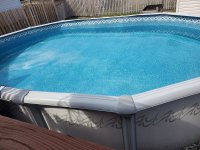Hey friends,
I bought a home with a pool that has been maintained with trichlor and cal hypo since 2006. I would like to test my water soon, even though I will only be officially opening sometime in May. My cover is off and the water is crystal clear and 54 F, and I'm super excited to open it (it's been an insanely nice spring thus far, but I'm sure we will get a surprise snowfall at some point soon.)
Because the water was only drained to a few inches below the skimmer line, I am worried about the CYA and CH levels. The plumbing isn't hooked back up yet and of course the pump cannot run at the current water level so I know I won't be able to take a representative sample. Is there a way to mix up the water efficiently enough to be able to take a sample? Would brushing the walls down be enough to mix up the water? Or manually vacuuming without actually vacuuming (no pump to form the suction)?
If the CYA and CH are off the charts like I anticipate them to be, I would rather drain the required amount of water prior to topping it up, which seems like it would be a non-required waste of water. But in order to figure out what kind of drainage I would need, I need to test.
The good news is that I received my K2006C test kit yesterday, even though it was supposed to take 3 more weeks!! *happy dance
The bad news, albeit slightly unrelated, the LC I thought I could buy @ $0.20/oz is from a company that only supplies a different company in my town, and therefore doesn't offer the refill price. Now the best price I can find is $0.37/oz... *sad dance
Thanks in advance! Haley
I bought a home with a pool that has been maintained with trichlor and cal hypo since 2006. I would like to test my water soon, even though I will only be officially opening sometime in May. My cover is off and the water is crystal clear and 54 F, and I'm super excited to open it (it's been an insanely nice spring thus far, but I'm sure we will get a surprise snowfall at some point soon.)
Because the water was only drained to a few inches below the skimmer line, I am worried about the CYA and CH levels. The plumbing isn't hooked back up yet and of course the pump cannot run at the current water level so I know I won't be able to take a representative sample. Is there a way to mix up the water efficiently enough to be able to take a sample? Would brushing the walls down be enough to mix up the water? Or manually vacuuming without actually vacuuming (no pump to form the suction)?
If the CYA and CH are off the charts like I anticipate them to be, I would rather drain the required amount of water prior to topping it up, which seems like it would be a non-required waste of water. But in order to figure out what kind of drainage I would need, I need to test.
The good news is that I received my K2006C test kit yesterday, even though it was supposed to take 3 more weeks!! *happy dance
The bad news, albeit slightly unrelated, the LC I thought I could buy @ $0.20/oz is from a company that only supplies a different company in my town, and therefore doesn't offer the refill price. Now the best price I can find is $0.37/oz... *sad dance
Thanks in advance! Haley




